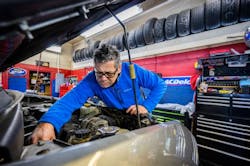No shop owner would immediately send a brand new hire with no experience out on the shop floor. It could result in damage to a car, and it would be dangerous for the new employee. Likewise, employees who rise through the ranks usually are taught how to take on their new responsibilities.
In other words, employees need to be trained to do the job properly. Fortunately, most business owners understand the importance of training their employees. Yet, what is often missing is the training that they as business owners should also receive.
Far too often, these business leaders don't do enough to get trained for their job – and though that may not be as physically dangerous, it can often be a detriment to their potential success, and even threaten opportunities for future growth. Many owners simply overlook the opportunities that are out there.
"Everyone should have training," explains Cecil Bullard, president of the Institute for Automotive Business Success. "Even I work with a group, and I regularly add to my library of materials. Training is investing in yourself."
Bullard, who has been coaching for 20 years and who has been in the industry for 41 years, further suggests that he's found that the average shop could risk losing $140,000 to $180,000 a year in profits by simply not being efficient. The blame isn't on the technicians on the floor, but rather the buck stops at the top.
"Shop owners need to understand their margins, how to sell value to clients, how to manage staff, and how to improve efficiency," he tells NOLN.
It may sound simple, but it isn't a matter of saying, "do this, and good things will happen." You can't take the sage advice, "if you build it, they will come" these days. Instead, Bullard suggests that shops need a comprehensive business plan that sets goals, which can then guide the owners step-by-step.
This can be overwhelming at first for many business owners, but a bigger issue is that some don't know there is a problem because they never engage in training.
"Training of the leadership, including owners, is definitely overlooked too much in the industry," says Dwayne Myers, owner of Dynamic Automotive in Frederick, Maryland. With five shops and 48 employees, Myers is now on track to open another shop by the end of the year. He tells NOLN that the time commitment is often what stands in the way for many shops.
"Owners and executives are so busy, and they feel they don't have the time for training, but I have come to see that it is simply like sharpening an axe before you start to cut down the tree," Myers adds. "But I get it, and it took me a while to understand. I started on the floor, and I was more introverted and wasn't outgoing – which isn't good in a business owner. I knew I needed a change."
Myers took a number of Dale Carnegie training classes on leadership, and it helped put his business on track. He has since started teaching the classes, and sends his leadership to take the training.
"Everyone who is in a leadership role with our company undergoes Mastermind peer-level training, and talks to these coaches," says Myers. "It has really helped us expand the business."
Training Addresses What is Missing
In many cases, business owners might not know what they're doing wrong, so they have little chance to actually improve. Operations could be moving along adequately. That may be fine for the shop's power washer or overhead doors, but it certainly may not be true for the shop.
"Training can help a shop see why it isn't hitting part margins," says Bullard. "We train owners and service advisors to see what they're missing. We also teach business owners the importance of hiring and interviewing, and how to explain to employees how to do their job."
Bullard also says that much of his work is with independent shops rather than large chains, which often have their own marketing and business models in place. However, he does run groups for owners of multiple shops, where he shares the importance of understanding private equity and how it can help with expansion goals.
"There are already a lot of challenges in the industry," Bullards adds. "One thing training can do is to help a shop owner looking to reach the point to get out find the way to do so. It is an interesting time in the industry, as there are now many older guys who may be looking to sell and retire, but they haven't reached that point because they aren't maximizing their company."
Those owners, in particular, may think they're the old dogs, who can't learn new tricks, but Bullard says that the right training could still help make the business attractive to potential buyers. "I see a lot of businesses where productivity is running about 72 percent, but my clients run over 90 and close to 100 percent."
This can be due to the fact that a lot of time is wasted because techs aren't given the right information. Streamlining the estimating process, so supervisors don't have to waste time in discussions can be just one way to improve the workflow. The result is what Bullard says it is "quicker, better, faster."
Setting Goals
Another key component of training may be to use it also set goals, not only just for the technicians but for those who wish to move up to manager, and higher levels at the company.
"We have one, three and five-year career goals," says Myers. "Anyone who says that they want to be in a leadership role will then get the coaching, even if it those goals are years away. We had one employee who wanted to be on a 10-year plan, where he wants to be managing a shop. In addition to his technical classes, he's starting with the leadership coaching."
Myers adds that this is a drip of knowledge approach, which can work better for many employees so that they're not overwhelmed. "We've done it the wrong way, where we've promoted someone without the training or preparation and it was a trial by fire, and the information is provided by a fire hose."
The Age of Online Consulting
Training in 2022 is vastly different than it was before the pandemic, with far more interactions occurring virtually. However, even before COVID-19, the experience had already been changing. Coaches and trainers are now spending less time in the shop, but the pandemic simply expedited the transition.
"I don't know any coaches that go into a shop for more than a day," says Bullard. Social distancing is just a part of it, another factor is that training is meant to improve a shop's workflow in the future, but can still impact day-to-day operations.
Now more consulting is done over Zoom and via other virtual channels.
"It was going to move online no matter what," adds Bullard. "COVID just made it happen a lot faster. It has also made clear some of the inefficiencies that come with online training. In-person is still very important, and our clients generally want to meet in person, as they get a lot more out of it.
This often includes meeting in a hotel conference room, or another professional setting, to discuss the issues the shop might have, followed by a day at the shop, which allows the trainers to understand the operations. This is followed by dinners and lunches with clients, and it is there that often yields some good results.
"Now we see a hybrid approach that includes virtual and in person," Bullard continues. "Online training can only take you so far."
A Group Effort
Beyond the training from specialized coaches, there are opportunities with local schools. Myers says that he now works with a local community college leadership program. "It is really good for team members of all levels, but especially management level as it teaches HR stuff, how to use Excel, and all the things a new leader would need to learn."
In addition to sending his employees to the classes, Myers and his managers now run the class once a year. It helps the team truly work as a team. "Our intent is that the class will help those moving up to leadership roles will be better prepared."
Business leaders can also enhance their skills via various groups, where information is shared by colleagues with similar experiences.
"We run 20 Groups, and these are some of the biggest bang you can get for the buck," says Bullard. "You are in a group with other owners. That can include someone who has a large number of locations and has gone through the various phases of a business. That person can explain what worked and what didn't work, and help you get there."
Moreover, not all of the groups that business owners may join will be entirely automotive-focused. There are plenty of options where one can join as a CEO to learn what a CEO does or should do via other groups.
"A lot of guys who are owners are simply spending so much time putting out fires, instead of running the business and that is holding the company back," Bullard notes. "There are so many opportunities for training. Anyone who says that training is available just isn't looking."
About the Author

Peter Suciu
Peter Suciu is Michigan-based writer and NOLN freelance contributor who has contributed to more than four dozen magazines, newspapers and websites. He lives in the land of cars not far from one of Henry Ford's estates.
